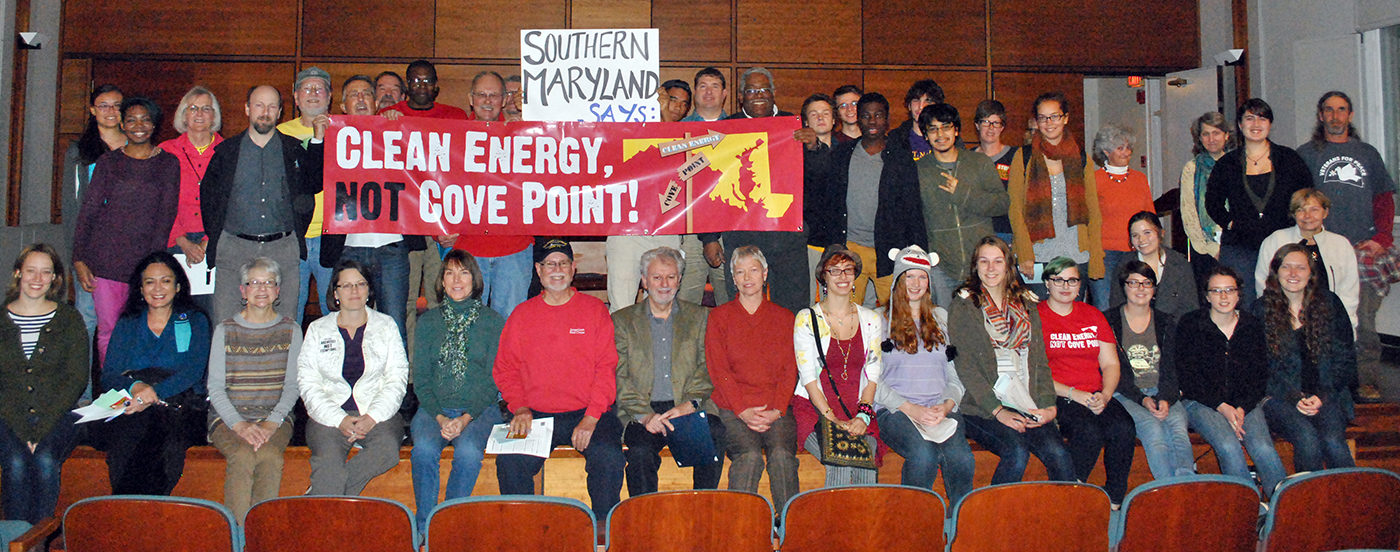For starters, Cove Point will need a new name. Rising seas from fossil-fueled climate change will eventually submerge the jut of land that gives this area its name.
But that’s only one longer-term consequence of Dominion’s scheme to liquefy fracked gas in Calvert County and ship it around the globe. The company’s planned $3.8 billion facility would change the historic and rural Cove Point area in ways we are only beginning to measure. This project would increase fracking, compressor stations and pipelines, jeopardizing towns all over the Marcellus Shale and wrecking our climate faster. But it would also industrialize the community of Lusby on the Chesapeake Bay.
Chesapeake Climate Action Network (CCAN) has released a fact sheet outlining the hazards — traffic, potential explosions, toxic chemicals, aquifer depletion, and air, noise and water pollution — that would make Calvert County the first community sacrificed to Dominion’s profits.
During the three years of the facility’s construction, for example, two-lane Cove Point Road, which is the sole evacuation route from Cove Point, would be clogged with heavy trucks and buses carrying workers. Traffic during rush hour would increase 89 percent on Cove Point Road and 50 percent on Solomons Island Road, according to Dominion’s application for a federal Certificate for Public Convenience and Necessity. Dominion’s definition of “public convenience” clearly misses the mark.
To help muffle the noise from the liquefaction plant, compressor station and new power plant, Dominion plans to build a sound barrier – six stories high and nearly as long as the nearby Governor Thomas Johnson Bridge. That wall would be the largest human-made structure in the county, but no one will be rushing out to make postcards of the view.
Toxins removed during liquefaction and stored on site would include propane, ethane, acid gases and cancer-causing benzene. Tanks of these chemicals would be stored so close together that federal officials have raised concerns about a “fireball” explosion. Nearby are five elementary or middle schools, a preschool, state parks and thousands of homes. And compounding the hazard, the Calvert Cliffs nuclear power plant is three miles away. Because of the existing, mostly dormant Cove Point import plant, Calvert County is already divided into four evacuation zones, but the community has yet to hear updated emergency response plans.
The proposed liquefaction plant and compressor stations would increase emissions of ozone-producing VOCs (volatile organic compounds) and nitrogen oxides (NOx). Yet Calvert County already fails to meet air quality standards for ozone, which is linked to premature death, heart disease and chronic respiratory damage, particularly in children and the elderly.
The new facility would draw 210,000 gallons of water daily (five times the current rate) from the Lower Patapsco aquifer and 85 additional 1,000-foot tankers into the Chesapeake Bay. Each tanker would discharge up to 25 million gallons of ballast water from India and Japan, potentially carrying to the Bay nonnative species, disease-forming microbes and even radioactive water from the stricken Fukushima Nuclear Power plant in Japan. To build this facility, Dominion would also clear nearly 100 acres of forest and disturb wetlands and waterways that attract tourists and support plants, animals and migrating birds.
While exporting liquefied fracked gas to Asia and trouble to Cove Point, Virginia-based Dominion would also be exporting its climate-disrupting energy vision to Maryland. This company plans to increase its wind- and solar-power generation a whopping 0.4 percent over the next 15 years. Maryland has a dramatically better vision. A good deal of the permitting for this facility, however, is from federal authorities. Let Senators Barbara Mikulski (202-224-4654) and Ben Cardin (202-224-4524) know that the more stringent Environmental Impact Statement should be required instead of an Environmental Assessment. (You can click here for a sample script.) As the CCAN fact sheet notes, this project costs as much as 12 Ravens’ football stadiums. It deserves the higher level of scrutiny.
And if you haven’t yet attended one of CCAN’s town halls, the “Clean Energy, Not Cove Point” Maryland Crossroads tour has two more stops — in Cumberland this evening, Nov. 20, at the New Embassy Theatre, and in Columbia on Tuesday, Dec. 3, at the East Columbia branch of the Howard County Library. About 130 people attended the tour in Salisbury last week, more than 160 people attended the stop at Hood College in Frederick on Monday, Nov. 18, and about 150, mostly students, were in the audience at College Park last night. WAMU-FM also recently repeated its segment on the project. (In the radio station’s unofficial poll, 71 percent now say Maryland should not allow the facility to be built.)
Concern about this facility is growing around the state. What Dominion had viewed as a stealthy and speedy process is proving to be neither.






